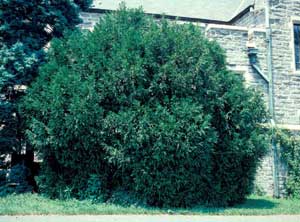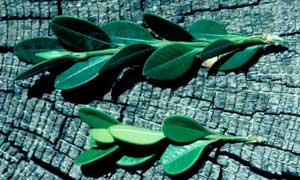Landscape Shrubs
Common Boxwood
(Buxus sempervirens)
Most of the landscapes in Arkansas focus on using hollies (Ilex) as the primary broadleaf evergreen but gardeners may want to take a look at boxwoods (Buxus) as an alternative. In Arkansas, we seem to have two ‘flavors’ of boxwood and the choice of one over the other seems to be linked to geography. There is a tendency to see more littleleaf boxwood (B. microphylla) in the Northwest corner of the state and more common boxwood (B. sempervirens) in Central and South Arkansas.
For those that have traveled in the Midwest or East you have observed littleleaf boxwood (B. microphylla) used extensively. This is especially true if you have ever seen formal or English gardens. Littleleaf boxwood is a very clean, soft textured plant. The small (5/8” long by 1/3” wide) medium green leaves have a semi-gloss appearance. Many gardeners often confuse boxwood with holly but the two are very easy to separate. Leaf arrangement on boxwood is opposite, and alternate on holly. One warning with littleleaf boxwood, be prepared for the leaves to turn a soft orange in February. This is especially evident on exterior leaves and plants that are located in full sun. Many of you will think that your boxwood is dying but in fact this is a normal event. By April the foliage will return to an attractive green again.
Unlike hollies, boxwood is a single season plant. The yellow-white flowers are very small and insignificant. The fruit capsule is also insignificant. Just for fun, you might want to split the horned woody capsule in half and your imagination will let you see what looks like the face of an owl.
The typical size on littleleaf boxwood is 4’ by 4’. This is one reason this plant is so favored for foundations or for low sheared hedges. From a cultural standpoint, littleleaf boxwood is ideally suited for partial shade. In Arkansas, plants located in full sun will likely be more susceptible to winter injury. The most common reason boxwood decline in a landscape is their intolerance of heavy, poorly aerated soils. Boxwood planted in heavily compacted soils in new landscapes or in soils with standing water will likely die quickly. Cultivars with the name ‘winter’ in them (‘Winter Gem’, ‘Wintergreen’) are common in the trade and have greater cold hardiness than the species although this is not a critical issue in Arkansas. Selections from the botanical variety japonica are supposedly better suited for the heat associated with Central and South Arkansas.
In Central and South Arkansas it is more common to see common boxwood (B. sempervirens) in landscapes. Common boxwood can be easily separated from littleleaf boxwood by differences in the leaf tip, leaf color (leaves on common boxwood are typically a darker green; new growth has a distinctive flat bluish/waxy green color), and plant size (common is often 15’ tall by the same in spread).
There are a large number of cultivars of common boxwood available ranging from variegated leaf cultivars (‘Argenteo-variegata’), weeping (‘Pendula’), and plant size (‘Vardar Valley’, ‘Suffruticosa’). ‘Suffruticosa’ is the gold standard as a dense, compact form for edging.
In 2011 a new fungal disease (Cylindrocladium pseudonaviculatum ) called ‘boxwood blight’ was reported in Connecticut and North Carolina. As of 2013, this disease had not been observed in Arkansas. Boxwood blight causes premature defoliation of plants and repeated defoliation and dieback can predispose plants to other pathogens.
- Common Name: Boxwood
- Varieties to look for: many
- Flower Color: NS
- Blooming period: spring
- Type: broadleaf evergreen shrub
- Size: littleleaf 4’ tall by 4’ wide; common 15’ x 15’
- Exposure: partial sun to shade
- Soil: good drainage and organic matter
- Watering: moist best
- When to prune: as needed
- Suggested use: edging, low hedge
Form

Comparison of Common Boxwood (Buxus sempervirens) at top with Littleleaf Boxwood (Buxus microphylla) at bottom.
